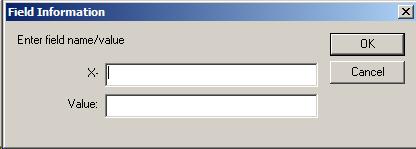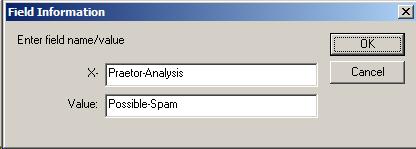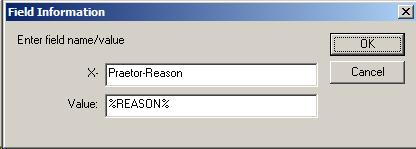
Add X- header field |
Optional |
This action is used to add a new X- message header field and may be used to provide results from Praetor's analysis that can be tested by client-side rules. If this header field already exists, this action will create new fields with the same name.
You specify the X- header field name and parameter value through the entry screen as follows.

For an example of how this can be used to great advantage and create client-server cooperative processing, see this FAQ #6.
There are reserved names for variable information that can be placed as the value for X-header field. Click here to see the list.
Set X- header field |
Optional |
This action is used set the value for a pre-existing X- message header field, replacing the original value for that field. When no such header field exists this action will cause a new field to be created, behaving exactly like the Add X- header field action above.
There are reserved names for variable information that can be placed within the X-header field. Click here to see the list.
The following case-sensitive keywords may be used to supply variable information from the message in question.
|
Reserved keyword |
Description |
|
%ATTCOUNT% |
Number of attachments
in the message, excluding embedded messages that might have their own
attachments. |
|
%ATTNAMES% |
List of attachment names separated by commas. |
|
%DIRECTION% |
Direction of the message, either "INBOUND" or "OUTBOUND". |
|
%GUID% |
Praetor unique message ID. |
|
%MAILFROM% |
The From address taken out of the RFC-2821 envelope. |
|
%REASON% |
Reason description as
seen in the Log Viewer application and taken from the recorded RSN file. |
|
%RULE% |
Rule description that caught this message. |
|
%SIZE% |
Message size as occupied
in the temporary file with attachment in its raw, undecoded (expanded)
size. |
|
%SUBJECT% |
Message subject taken from the RFC-2822 message header. |
|
%TODAY% |
Today's date. Example: Friday, 13 September, 2002. |
Flag the message as spam |
Optional |
This action automatically adds the following line into the message header:
X-Praetor-Analysis: Possible-spam
This is equivalent to manually using the Add X-field action and setting the fields as shown below.

Add the reason why the message was caught |
Optional |
This action automatically adds the following line into the message header:
X-Praetor-Reason: <variable text with reason>
This is equivalent to manually using the Add X-field action and setting the fields as shown below, taking advantage of the %REASON% keyword.

Add name of rule that caught the message |
Optional |
This action automatically adds the following line into the message header:
X-Praetor-Rule: <variable text with the rule name>
This is equivalent to manually using the Add X-field action and setting the fields as shown below taking advantage of the %RULE% keyword.
